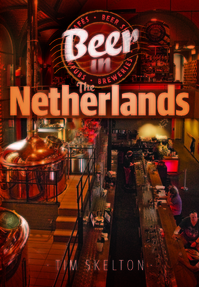The craft beer revolution is going Dutch
Added: Saturday, July 5th 2014

Beer in the Netherlands, Tim Skelton (Homewood Press £13.99))
This is a long-overdue companion for beer travellers. As Tim Skelton, who is based in Eindhoven, points out, the last English-language guide to beer in the Netherlands was Tim Webb’s Good Beer Guide to Belgium & Holland in 2002. The publisher, CAMRA Books, decided to confine this best-selling book to Belgium on the grounds that it has far and away the most interesting selection of beer.
But the world of beer is a restless place and the craft beer revolution has raised its standard in a country for too long dominated by Heineken’s lagerade. Tim Webb is aware of this development as he is the series editor of the first book from a new imprint and even manages to get the name of country right this time.
The format will be familiar to users of Good Beer Guide Belgium, with the same designer, Dale Tomlinson, excellent photography, potted histories of the country and its beer, and advice on how to get there, where to stay and what to eat. And the jokes and irony are good, too. The directors of Heineken won’t be ordering too many copies.
The main body of the book is a guide to Dutch breweries, of which there are now many. Skelton says that in 1975 a beer guide to the country would have been a pamphlet, with just 22 breweries. Today there are 200 and the number is expected to go on rising. If the images are anything to go by, many of the new breweries are smart, highly professional and commercial. And there’s a lot of wood around, as Dutch brewers join the rush to age beer in oak. There is even a Dutch attempt at brewing lambic – but don’t tell the Eurocrats or they will send the heavies round.
Inspired by American, Belgian and British beer styles, you will find blond ales, Bok, Dubbel, IPA, Oud Bruin, Rauch, Saison, Stout, Tripel and Witbier, as well as the Dutch versions of gruit, beers made with a mixture of herbs and spices.
The Netherlands has its own Trappist brewery at Koningshoeven near Tilburg. The monks, as Skelton says, made the mistake of confusing God with Mammon, allowed the brewery to fall into the hands of Bavaria, a big brewery that concentrates on beers for supermarkets, and as a result lost its “Authentic Trappist” logo. It’s now back in the fold, having assured God, the Pope or whoever decides these things, that the brothers are firmly in charge of brewing. You may take this with a grain of salt as you place your tongue firmly in your cheek, but what is indisputable is that the beers, the Tripel and the Quadrupel in particular, are fine beers. There’s even an oak-aged version of the Quadrupel that I am keen – nay, frantic -- to sample.
The other main section of the book, in true Webbian style, is a guide to the best bars in the country, broken down in to regions. There are some tempting entries but, being a creature of habit, I was delighted to find some of my favourite watering-holes in Amsterdam alive and kicking: Bekeerde Suster, Elfde Gebod, IJ and Wildeman. But, prompted by this excellent guide, I will be more adventurous on my next trip.
*Available from www.booksaboutbeer.com








